A few days ago I had a chat with Bridie Schmidt for her Elevate EV podcast. You can listen to the podcast or read the transcript below (automatically generated by Descript and lightly edited by me), with some of my photos and videos added for extra information and colour.
———
Bridie Schmidt: Welcome to the latest episode of the Elevate EV podcast where I take you on a road trip to the world of EVs and the future of sustainable transport. I’m your host Bridie Schmidt. Firstly, I’d like to acknowledge the Bundjalung people, traditional custodians of the land on which this podcast has been made, and pay my respects to their elders past, present and emerging.
I extend that respect to all Aboriginal and Torres Strait Islander peoples who may be listening. Joining me today is Neerav Bhatt, a fellow journalist focused on helping Australians switch to electric vehicles as well as making their home fully electric and sustainable.

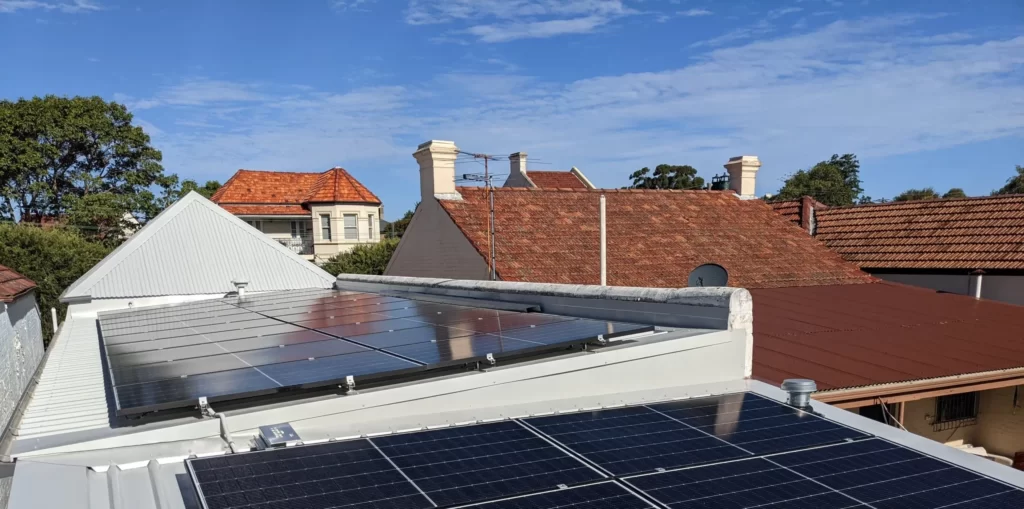
He currently writes for his own site at Electrifiying Everything and for TechAU. He also spends a lot of time on Australian social media and chat forums providing information about EVs and answering frequently asked questions and has a YouTube channel called Electrifying Everything which he is experimenting with.
I’ll add some links in the show notes. In today’s episode we take a look at real world range and that little number some call claimed range, but which is actually more officially known as the WLTP standard and is a globally recognised lab test for fuel efficiency. We also look at what new EV owners can do to find out the difference between the two before taking off on the next holiday road trip.
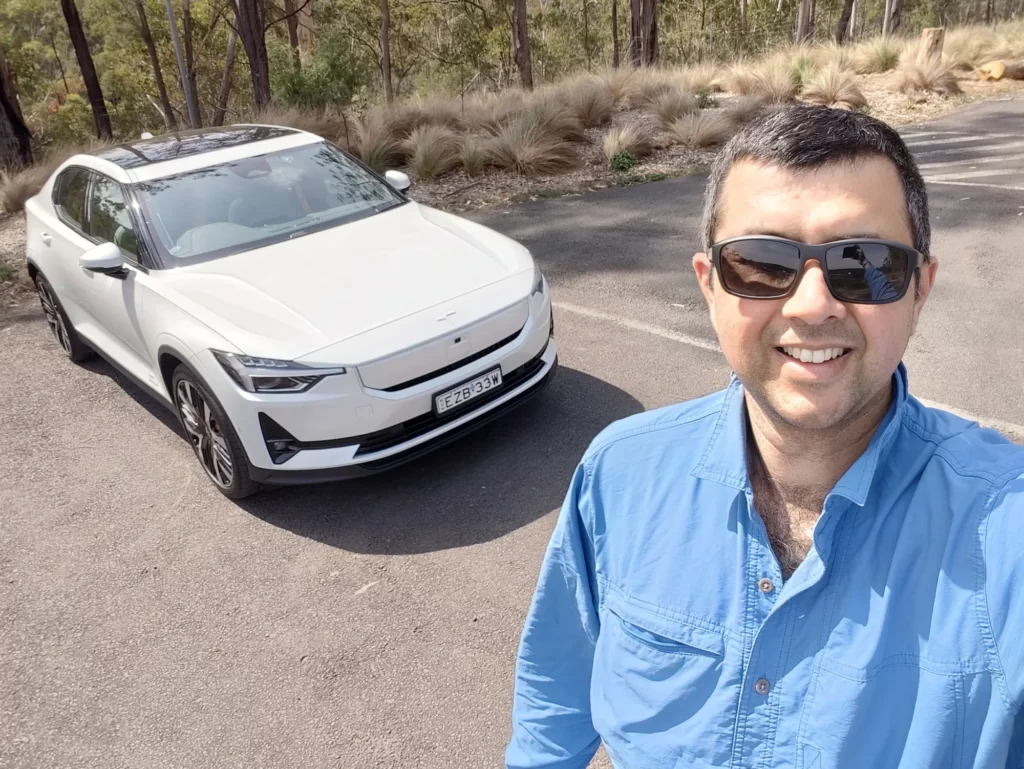
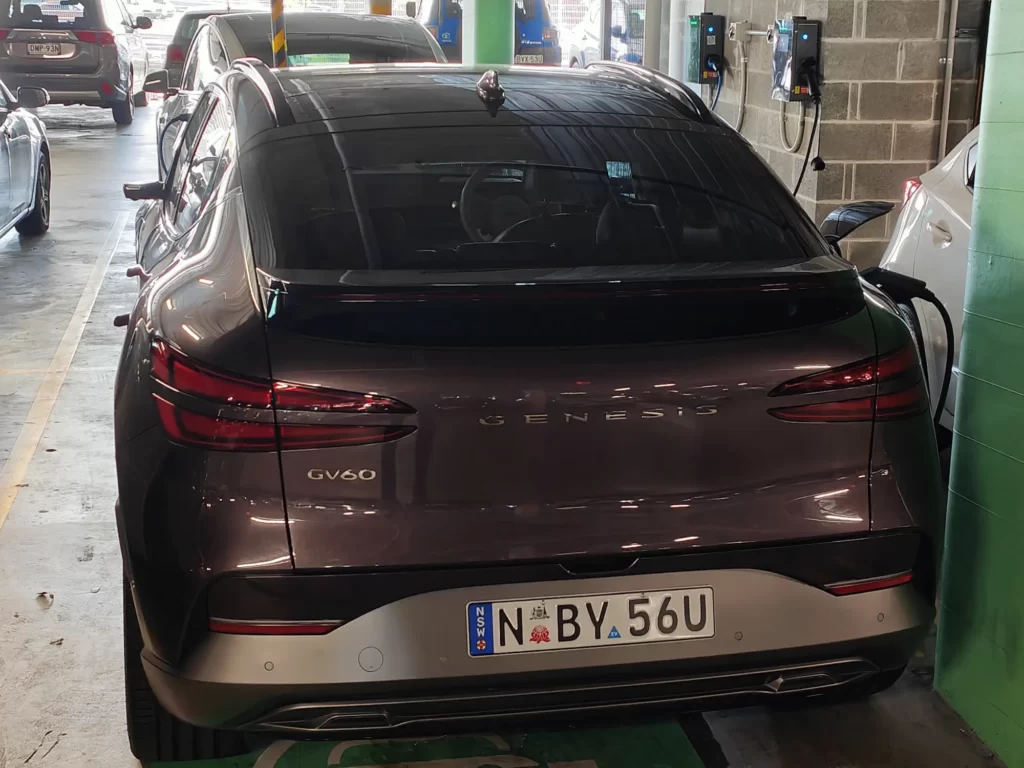
Neerav also tells us about the 2024 Polestar 2 and the Genesis GV60, two high end electric vehicles that offer very different driving experiences.
We also touch on the role of government policies in promoting EV adoption and discuss the importance of time of use pricing for EV charging, the challenges of retrofitting old apartment buildings with charging infrastructure and the potential for street level charging solutions like Jolt’s 25 kilowatt DC chargers.
Finally, we wrap up with a bit of a debate on boost modes in electric vehicles. Now the long range Model Y is getting this upgrade. Are they just about bragging rights? Don’t all EVs technically have a boost mode? So buckle up and get ready for another electrifying episode. Let’s get started.
Bridie Schmidt: Hello everybody. Welcome to the Elevate EV podcast. I’ve got here with me Neerav Bhatt, who is an independent journalist focused on helping Australians switch to electric vehicles, as well as making their homes fully electric and sustainable. Welcome Neerav.
Neerav Bhatt: Morning Bridie. Thanks for inviting me.
Bridie Schmidt: I saw you do some writing for TechAU, but you’ve also got your own blog. It would be nice to sort of find out what got you into EVs.

Neerav Bhatt: I’ve been a technology journalist and photographer for about almost 20 years. Now it makes you feel old when you think about when you started, more recently I switched into covering sustainability and electric vehicle topics .
A decade ago I covered cars occasionally eg visiting Ford Engineering HQ down in Victoria and writing magazine articles about how electric cars were the future of motoring in Australia but I’ve never owned a petrol car.
I’ve driven my parents petrol car and Goget carshare every now and then but I didn’t want to own a car unless it was not polluting. So I was waiting and it was a long wait. I guess I had the luxury of being in Sydney where we have decent public transport. Not everyone has that choice obviously, even in some parts of big cities


Bridie Schmidt: So EVs have really only been around for a couple of years in, in any volume in Australia. It sounds like you were waiting a while then.
Neerav Bhatt: I was. Initially obviously Teslas were the only game in Australia but I was waiting for there to be a bit more choice and affordability because let’s be realistic, not everyone can afford a 100K, 80K, even 60 or 50K. So it’s really exciting recently for example to see three new Chinese made EVs that are under 40 K if you get the base model before on roads.
Bridie Schmidt: Yeah, that’s right. The BYD Dolphin, GWM Ora and the MG4. It’s really interesting to see what will happen over the next few months I think, because they’re all coming onto the market now, aren’t they?


Neerav Bhatt: Yes. It’ll be interesting to see which ones people are interested in purchasing and if they can get enough stock in.
I think besides the fact that Tesla and BYD have strengths of their own, one of the reasons they sold so many in the last year or two was because they could get a lot in. Simple supply and demand. People really, really wanted an EV and if those are the ones that they could get quickly, that’s the one they bought.
Now that there’s a lot more brands available and a lot more models and a lot more pricing levels. Hopefully there’s more supply via ships from all over the world coming in and we’ll see what the true brand preferences are.
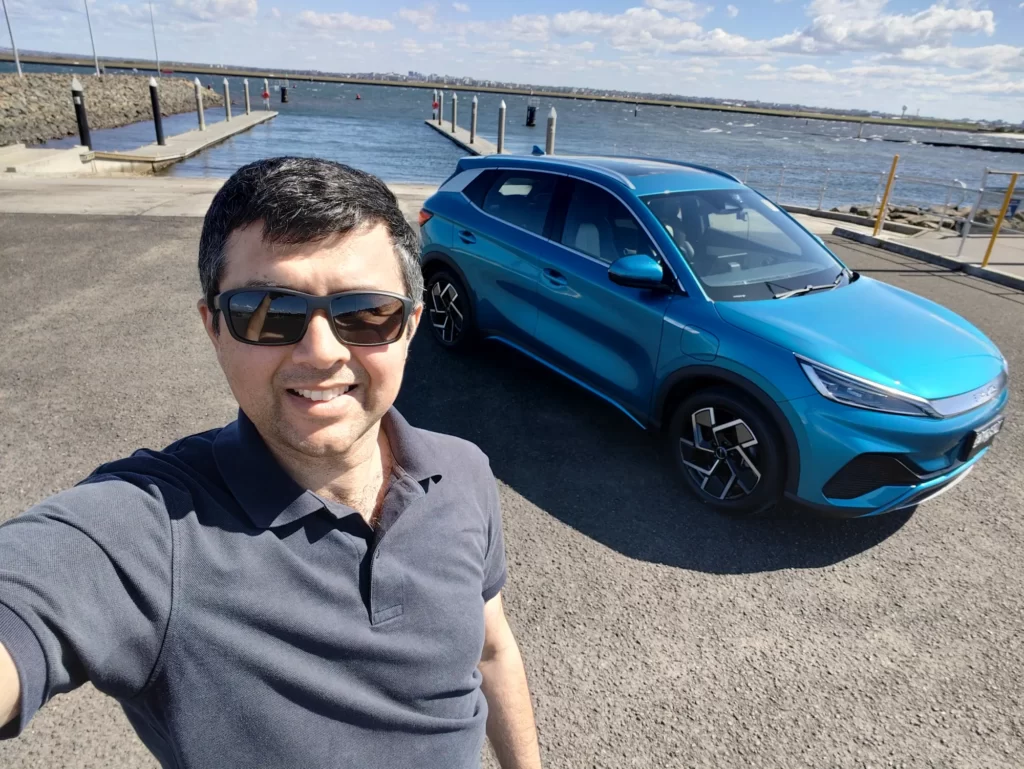
Bridie Schmidt: Yeah, that’s a really interesting point. I guess a lot of people chose Tesla because they’d be able to access not only the Tesla supercharger, but also other charging networks.
Do you think that opening up the Tesla networks is going to be something that will get more people on board along with the rollout of more national networks, such as that with the NRMA?
Neerav Bhatt: I think it all helps but it’s not clear cut because Tesla quite sensibly has only released a bit less than half of their chargers for any brand of EV to access.
They tend to be the ones that are in less popular areas on less popular routes to a large extent. That’s fair enough it’s their commercial prerogative. The catch is Tesla’s work perfectly with Tesla chargers because it’s the same company and it’s been tested, you know, millions of times. But other brands are finding that when they connect, sometimes they don’t work.
There’s been reports of BYD, GWM, MGs, all having trouble, certain brands, certain models, certain batches, connecting to Tesla superchargers.
Then even when you can connect, other brands are finding that because of the way the car was engineered and the Tesla chargers were engineered for 400 volt systems, your more advanced 800 volt EVs like Hyundai, Kia and Genesis only charge at about 40 kilowatts on some types of Tesla superchargers, which is not very fast.
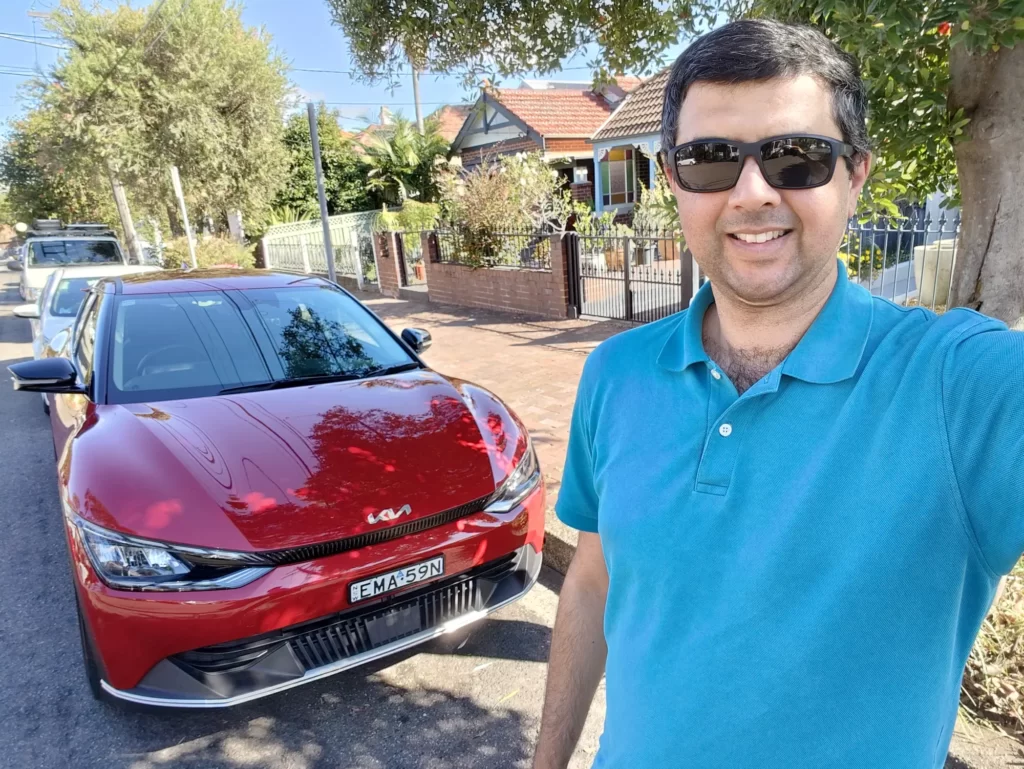
So why would you pay the premium Tesla price, unless you know that your particular car model will One actually be able to connect properly and Two, get a decent speed to justify paying the premium price.
Bridie Schmidt: Well, that’s right, isn’t it? It’s must be disappointing for Kia and Hyundai owners or their luxury brands because they are some of the cars that get the highest charging speeds in Australia, aren’t they?
Neerav Bhatt: Yes. Yeah, I’d actually tested the Ioniq 5 recently at an EV charger, a 350kW near Goulburn and yeah, it was bang on the promised 10 to 80 percent in 18 minutes.
Bridie Schmidt: That’s really great. Isn’t it? Especially for people who are on their holiday road trip or doing the drive between Sydney and Melbourne.
Neerav Bhatt: From a much more affordable car perspective, I borrowed an MG ZSEV Excite last Christmas and did a family road trip from Sydney to West Melbourne and back again on the Hume. I got to spend a lot of time at Chargers talking with people because that car doesn’t charge very fast.
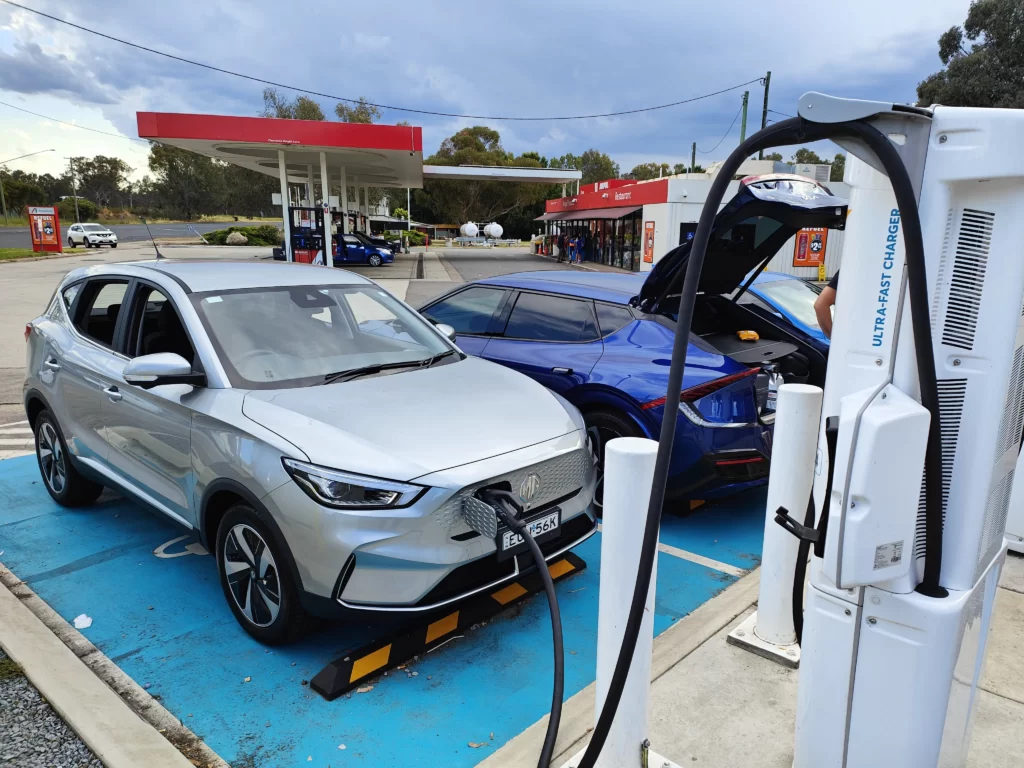
And yes, it does make a big difference. You know, you’re sitting there. It’s not just MG, there are plenty of other models. That don’t charge as fast like the Kia Niro, the BYD Atto 3 doesn’t charge that fast either. And at the same time, you might see, Audi e-tron or an Ioniq 5 or an EV6 and they’re gone long before you finish.
Bridie Schmidt: And why is that exactly? Just for people who aren’t so tech savvy? Is it to do with the onboard charger in the car?
Neerav Bhatt: That’s true. Yes. Generally speaking the more expensive the car as a rule of thumb, the more speed it will be able to charge at, accept charge at from a charger. So all cars are going to charge slowly at a slow charger because the charger is only outputting electricity at a low rate.
But when you get to an ultra fast charger that says 350kW or 200kW or 150kW, your car’s actually going to be able to accept that. And not all cars can do that.
Bridie Schmidt: Australian EV sales are on the increase and we’re beginning to see queues at chargers. What do you think that effect is going to have? Like this Christmas is we’re going to have the most EVs on the road that we’ve ever had in Australia.
What’s going to be happening out there? Do you think?
Neerav Bhatt: I think that people who already own their EVs will probably have already done road trips before at Easter or other times of year, will probably be relatively well prepared. It’s the new people who haven’t done it before that may experience, quite likely experience frustration, especially people traveling with families, whether it’s a lot of adults or children attached.
They tend to go for the same big charging locations, like ChargeFox Euroa in Victoria, because there’s lots of food options and toilet facilities available, and there’s not that many charges. So you could be waiting a long time. If there’s a decent leaf plugged in ahead of you, you could be waiting a really, really long time as an example.
But even some of the other brands, like I said before, I think it’s actually possible that in the next year or two, we’re going to see so many EVs sell that despite the best efforts of EV, ChargeFox, AmpCharge, BP Pulse, their rollout is just not going to be able to keep up, it just takes a lot of time and effort, which people may not appreciate to get planning approvals, land, hardware, labour.
As we know that labour is in short supply across Australia, pretty much across a lot of specialized professions. It can take a year to a year and a half to get a fast DC charger set up from first approval to actual activation.
I think it’s possible that some people might buy EVs and sell them soon afterwards. Not a lot but there will be some cause I’ve seen it happen in the US and the UK. They just weren’t ready for the reality.
Bridie Schmidt: I think that’s a really good point. It’s probably a good time to talk about, well, What can people do?
I have seen a lot of people going on to Facebook groups, for example, and asking questions, which is fantastic. And it’s so encouraging when you see EV owners sharing the knowledge that they’ve got, um, what sort of tips or suggestions would you have for new EV owners before they go on their summer trip?
Neerav Bhatt: First tip would be go on a weekend to get good practice for driving two, three, four hundred kilometres. If that’s not possible, at least you’ve got more daylight to drive in compared to winter. Go for a 150K, 200Ks in one direction if you can and back again in a day. So you get used to all the ways that your car is set up, for longer driving.
How fast the battery gets depleted, depending on your driving style, because that makes a huge difference. I’m not a lead foot. I can go a lot further on the same battery compared to someone who’s really smashing the accelerator.
Bridie Schmidt: My first EV was actually a plug in hybrid. It was a 2014 Mitsubishi Outlander. So it was a really good way for me to ease into owning an EV.
It had a type one plug. So for those out there listening, all EVs that you buy now for AC charging, we’ll have a type two plug. But when I had this plug in hybrid, it had this type one plug. I had a type one to type two adapter, but I didn’t know about how slow type one was.
So that was a bit of a learning curve, even for the small battery and the plug in hybrid.
Neerav Bhatt: Yeah, that’s a really good point. So when people do these practice runs that I’m suggesting on a weekend, try and get your battery down to maybe 30%, 25%. Don’t go too low. There’s a lot of people who really want to be heroes and charge at like 5% or something.
That is super risky. There have been, you know, one in five times or whatever, you end up at a charger and it’s under maintenance, someone’s broken it,or there might be a queue of 5 people. You don’t want to be stuck there because that’s your only choice. You want there to be different options. So run it down to maybe 30%, go to a decently fast charger and see how long does it really take to charge.
you can actually add your buffers into your journey planning. I was listening to other families talking to each other while charging last Christmas, one of the things that I heard from probably the non EV enthusiast spouse or a family member was why is it taking so long? And the other person had to explain it to them because they hadn’t actually done any practice runs before.
Bridie Schmidt: That’s a really good tip as well. You want to sort of prepare your family members to temper their experiences. So maybe take your most resistant family member. with you can take longer, but it also means you can step out and have a break while the car charges. Yeah. Yeah.
Neerav Bhatt: In fact, it doesn’t have to be seen as a negative. I’m not a fan of, look, unless it’s like an emergency and you have to get from Sydney to Brisbane or whatever in one day, it’s really not safe to try and do it in one day. You don’t get a hero badge from me for trying to do it in one day. Take time. It’s more enjoyable for the driver and the passengers.
Stop somewhere, you know, going from Sydney to Melbourne, pause at Jugiong, buy some jam. If you have some kids, let them play at the play equipment. Give yourself some peace and quiet, even if you don’t have kids. I like to have an ice cream every couple of hours, maybe if it’s hot or a cold drink, or just go for a walk cause I’m six foot three and even in spacious cars, I need a proper stretch.
Bridie Schmidt: I’m not as tall as you, but I need to stretch my knees too. It’s not just about the charging experience. It’s also about expectations around driving range.
You have a YouTube channel where you post videos of your driving range tests?
Neerav Bhatt: Driving range has so many different factors if it’s really cold, you know, you live in Tasmania or you’re driving in Victoria in the middle of winter, you’re right the range is just going to be shorter, especially if you have the heating cranked up.
If you’re driving up a mountain one way, your range will fall really quickly, but then you’ll find when you’re driving back down the other side of the mountain, your range will pick up due to regenerative braking if you’ve got that turned on and your car has a strong regenerative braking feature.
So when I was doing my range test videos, I realized I love data. So I was looking at the altitude changes and like, you know, Sydney to Goulburn and then Goulburn to Sydney, completely different data because one way you’re going up a slope and the other way you’re going down a slope.
Bridie Schmidt: I’ve always found it interesting that when you look at those, the energy use line kind of echoes the hill that you’re driving up in a way.
Neerav Bhatt: Yeah. And other factors will make a big difference as well. Same as in a housebecause I’m interested in sustainable houses, if you leave your house on, you know, Arctic 18 degree conditions, your air conditioner is going to be using a lot of power, whereas if you put it on maybe 23, it’s going to be using a lot less power.
And in winter, if you’re cold in the car, I found if your car has these features, it’s much less energy use to heat the seats and the steering wheel than it is to heat the whole car
Bridie Schmidt: Unless your car’s got a heat pump in it, it’s using resistive heater.
Neerav Bhatt: In winter, my family keep the heater on, you know, 20 maybe, or, but we walk around in fleece pants and, you know, jumpers. So if you’re driving in winter in like shorts and a t-shirt with the heating cranked up, that’s going to use more battery.
Bridie Schmidt: Getting back to the idea of people going out and getting an idea of what the real world range of the EV that they’ve bought it, hopefully they’ve come across some information already about the difference between WLTP range which is a lab test to compare vehicle energy or fuel efficiencies and what the difference between that and the real world range is, how would you recommend people get an idea of their range on their EV before they go on a big road trip?
Neerav Bhatt: I guess I would say three things, your average car dealer website will put the WLTP range number. Though I do notice BYD sometimes puts a different number, which is a lot higher. It’s called NEDC and I call it never even damn close.
Bridie Schmidt: Not even damn, yeah, not even damn close.
Neerav Bhatt: I’ve seen some new non technical electric car purchases say that, Oh WLTP that’s a lie I never achieve it.
It’s not a lie. It’s just, you’re interpreting it differently. That number is an average of city and motorway. So generally speaking, electric cars are different to petrol cars. In the city, an electric car will do a lot better than it’s promised range. It might do about 20 percent better. But on motorway, usually it’s about 20 percent less.
Bridie Schmidt: It’s a big difference, isn’t it? And I noticed I had to take a… a quick drive this morning and on the energy consumption screen, the battery was saying it had 260 or so kilometers left in it, but according to the way I was driving the car at the time, if I kept on driving that way, I apparently would be able to get 410 kilometers, it goes to show that If you can keep an eye on how you’re driving, you can get the most driving range out of your car.
Neerav Bhatt: Yeah, something else that’s important is, probably no one will admit it, but a lot of Australians do casual speeding. And, you know, a lot of the time I have loaned cars and I want to treat them well and test them and drive legally.
So I set my car at the actual limit, a lot of people set it at the GPS limit, you could do that too if you want, but it’s a bit more on the edge because going downhill, some brands like the Polestar 2 overshoot by about five or six kilometers. If there’s a speed trap at the bottom of the hill and you’re going at GPS speed, plus a few more km, cops could get some money out of you.
Also, the faster you go in an EV above 90, 100 kilometers, the thirstier your car will be, it can get quite thirsty. And I know from people who’ve kind of on the quiet told me that they actually drive at, you know, 120km/hr on a motorway. That’s why their efficiency level is not that great. The car’s a lot thirstier at 120km than it is at 110km or 105km.
Bridie Schmidt: Yeah, that’s right. So, and so the range tests that you’ve got on YouTube, I noticed a lot of them you’ve done going up hills?
Neerav Bhatt: Because I log the altitude as well as the live speed on my range test videos, I happen to notice the better engineered cars with better regenerative braking re gather a lot more of the electricity going down slopes compared to the, some of the cheaper cars.
Bridie Schmidt: Oh that’s interesting
Neerav Bhatt:. So as an example the MG ZS EV, which is a perfectly serviceable car, doesn’t have regen braking when you have cruise control on. Just, it’s a hardware limitation. There will never be a software patch for it. It just is what it is.
Bridie Schmidt: That’s interesting. I did not know that. Whereas I know that the Tesla does, when I’ve got it on autopilot, it’ll, it’ll recoup that energy on the way down the hill.
Yeah.
Neerav Bhatt: And then there’s, uh, not to pick out any particular brand in particular, so I’ll just choose a different one. Say the BYD Atto 3. The regen braking is not that strong. So it’s not going to gather back as much electricity on the downhill slope either.
Bridie Schmidt: And so some EVs, you can actually pick the level of regeneration too, can’t you? Is that generally in the more expensive brands?
Neerav Bhatt: Generally but that’s changing now. Like the MG4 has lots of different levels from almost off to one pedal, full one pedal driving. Which is good to see on a more affordable brand. Some cars like Teslas, Elon chooses your region braking level for you. It just is whatever the car software at the time decides.
I like the way that Hyundai Motor Group and Kia do it, which is to have paddles on the back of the steering wheel. So you can adjust it as you go and you don’t need to stuff around touching any touchscreens.
Bridie Schmidt: Yeah, I had that in my Mitsubishi Outlander too. I really liked it actually. It gave you that good balance.
So let’s move on to some EVs that you’ve been doing test drives in lately. And I think firstly, you’ve been in the new Polestar, the 2024 refreshed model. What did you think about that? Yeah,
Neerav Bhatt: I’ve been in that one for a week. And at the moment, I’ve got a Genesis GV60, which is the premium Hyundai brand for a bit over a week as well.

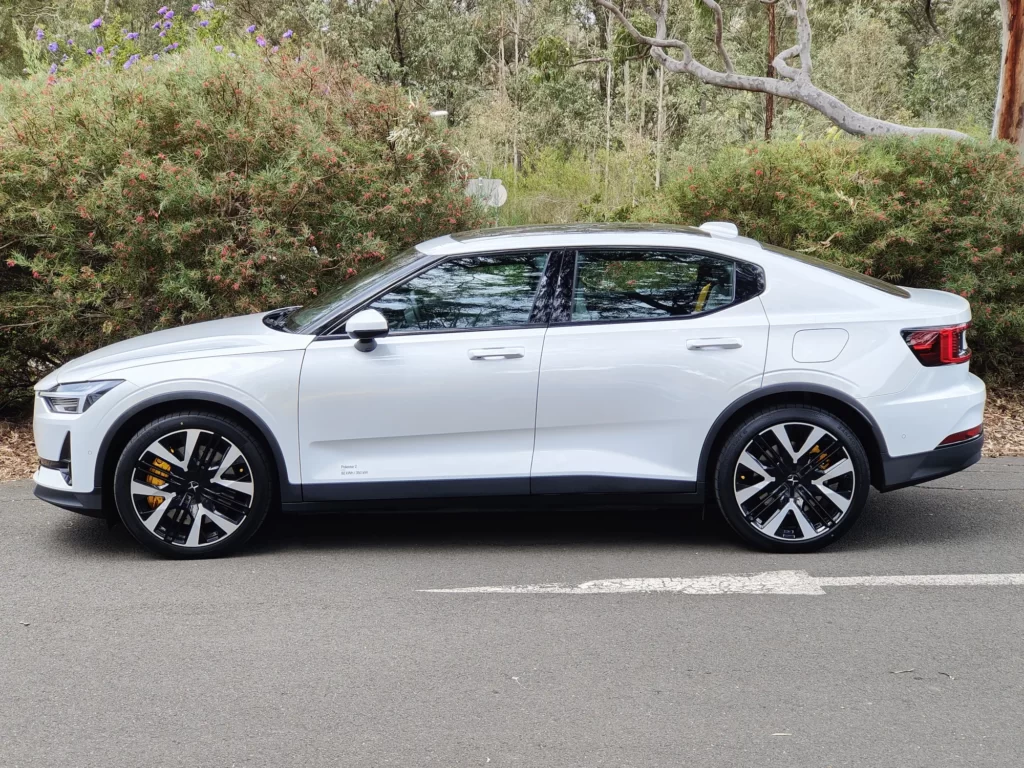
And it’s really interesting to see that they’re not exactly the same price, but they’re both not cheap. They’re both substantial amounts of money, but they’re a very different driving experience. So it’s not the case that spending a lot of money will get you a similar driving experience. You’ve really got to sit in the car and have a go at it to tell What it’s like, and each each of those vehicles will suit different people in different ways.
So the Polestar 2 that I had was like the top of the range performance version and the suspension is hard. Look, it’s a first world problem not comparing to like poor countries. It’s not horrendous, but there’s lots of bumps and little holes and little repatched parts on the roads in my area. And you can feel it in your bones in a Polestar 2 Performance because the suspension is tweaked to be really sporty.
Whereas in comparison, The Genesis GV 60, it feels like driving in your favorite comfy sofa with lots of technology in it, like super comfortable. In fact, what I found was I went on a bit of a longer drive the other day, and after an hour I found a feature that I didn’t know existed, which was the. Bottom of my seat, lumbar area was started massaging me.
It was, that was nice, but it was unexpected because I didn’t realize that was a feature.
Bridie Schmidt: The Polestar starts at just under 70,000 now, I think for the single standard motor but it goes up to 140,000 or so for that, that high performance. dual motor model one, doesn’t it? Whereas the Genesis is it’s all aimed at the top end
Neerav Bhatt: Which is a little bit disappointing overseas in the UK they have more affordable rear wheel drive Genesis GV60s available as well. Unfortunately, they decided not to include them in the range in Australia.
Bridie Schmidt: So what about the Polestar, so this is the 2024 model. I know there’s there’s been a couple of changes, haven’t there? One issue I’ve always struggled with, with the Polestar 2 is that it’s not on an all electric platform.
So it’s got that tunnel for the driveline from, I think Polestar and Volvo make petrol versions on the same platform.
Neerav Bhatt: Correct. Yes Polestar has made a lot of changes but compared to the initial model, the basic body is still largely the same. There’s a huge transmission tunnel and the center console next to the driver and the front passenger is really big, like the biggest of any EV I’ve driven, and that polarizes people, you know, there are people who like it, I’ve heard it described as sitting in a fighter jet cockpit.
So if that’s what you want to do. That’s the car for you because that’s the snuggest, I think that would be the nicest way of putting it. It’s the snuggest cockpit style seat. There’s plenty of leg room in front, but nothing on the sides.
Bridie Schmidt:. Yeah. I mean, I love the design of the Polestar. They’ve got a real, a really strong brand ID in the design of their cars.
But the, the 2024 Polestar 2 has got some specific changes, doesn’t it? Not just on the exterior, but also underneath, underneath the floor.
Neerav Bhatt: It used to to be all front wheel drive for the base models, but now you can get rear wheel drive or dual motor front and rear. They’ve also increased the range. They have increased the charging speed. They’ve improved the front to remove the grill and put in a new sort of sensor panel instead. They’ve also reduced the carbon footprint, which to their credit, as far as I know, Polestar is the most transparent company when it comes to the Carbon footprint of their cars from cradle to grave.
Bridie Schmidt: Yeah. They’ve got that project zero. I think it’s called where they’re looking to decarbonize every inch of the manufacturing process.
Neerav Bhatt: It’s an interesting project and it’s good to see. I wish other car companies did something like that. Or at least iteratively tell people what they’re doing to reduce the emissions of their cars.
Both in the production process, the driving process, and in the post life as well. Beyond what seems to be common in other brands is we’ve given you some recycled plastic seats, for example, that seems to be about as far as most other brands go.
Bridie Schmidt: Yeah. Or, or vegan leather, which I’m still not convinced of the sustainability of. It does mean less cows dying for huge amounts of upholstery, but yeah.
Neerav Bhatt: I’m not a huge fan of that phrase, vegan leather. It sounds like a dystopian, like sci fi future novel where the leather’s made of vegans.
Bridie Schmidt: Now that you put it that way, I’m not going to be able to unthink that.
Neerav Bhatt: It’s plastic. Let’s, let’s just be honest about it. Yeah, I much prefer the cloth seats and this is Australia if you have a black so called vegan leather plastic really it gets hot if it’s in the sun.
Bridie Schmidt: I remember a few years back BMW had a concept in which they were going to make an EV and every bit was removable and replaceable. I don’t know what’s happened to that, but I mean, I think that’s a really good idea.
Neerav Bhatt: It’s an interesting idea. My background previously was in the technology journalism space and companies have tried that, uh, like Nokia. I think they currently have a phone, which if people remember the old Nokia days where you could drop it and you’d be more about worried about it making a dent in the floor than the phone itself and just break up into bits and then you’d click all the bits together, like Lego and be on your way.
Bridie Schmidt: And you could replace the battery if you wanted. I had one of those. Yeah. Yeah.
Neerav Bhatt: That’s a good point. Australia has a frankly embarrassing lack of fuel efficiency standards, come on Albo, get that going (He’s my local member as well).
Bridie Schmidt: So you need to get down to the local Vietnamese pork roll shop and talk to him about it. Yes.
Neerav Bhatt: I think Labor’s done a lot of good things at federal level for sustainability and action on climate change but they’ve still got a lot of things to do. And even what they’ve done, they’ve been too slow.
You know, we’re in a climate emergency. We don’t need to have endless years and years of consultations. I find that really common in Australia, across the board. Like, consultations about electric buses. We don’t need consultations. China’s got countless, thousands of them. Maybe tens or hundreds of thousands of them.
It’s a done thing. Like efficiency standards. Let’s just admit that other countries are doing it better than us and say, we’re going to adopt the New Zealand standard, or we’re going to adopt the Californian standard. We’re going to do it in six months. Done. Don’t need to have endless talkests about it
Bridie Schmidt: No, I suspect they’ve got a lot of behind the scenes lobbying going on from, shall we say incumbents that don’t want to have to change things too fast.
Neerav Bhatt: Tough luck incumbents. You’ve had your day.
Bridie Schmidt: I know there’s been a bit of debate going on about the New South Wales decision to cut the EV rebates. And it’s a bit of a, a chicken or the egg thing, I suppose, because obviously we’re getting more uptake.
That’s great. And as you were saying, we really need charging infrastructure to catch up with that uptake. They take a while to happen. What do you think though? 3,000 or more charging infrastructure is what’s going to get more people over the line on EVs?
Neerav Bhatt: I take a less black and white view of this than a lot of EV commentators who are like give us our 3,000 rebate.
It’s not that simple. So across all levels of government in Australia, people want government services and the economy isn’t doing not that great. So government budgets are a bit tight and they have to cut in some places. I think the rebates. across all the states were too generous to some extent in not being means tested.
I know, for example, a quite wealthy person who’s got two EVs with rebates in New South Wales. They didn’t need any rebates. They could afford to have bought both of those cars in cash. It’s a waste of government money to give someone like that a rebate.
So if they could have kept the rebate in some way, maybe make it smaller and make it more targeted to say it’s means tested to incomes below a sensible amount and not like a lot of Australian government things where they make the caps so high to stop offending anyone that it’s meaningless and also make it.
So it’s only cars that are below a certain amount below 50 or below 45 really increase the volume of those semi affordable. Cause there’s still only semi affordable. You know, there’s plenty of people like on my street who like students or live in chair houses.
For them, 45, 50 grand is still a lot of money. They’re buying, you know, your Kia Picanto for 20 grand or an MG3 for a similar amount of money.
Bridie Schmit: I think when those rebates were introduced, we didn’t have those cars on the market, so it wouldn’t have made any sense. But yeah, it certainly sounds like it’s a policy setting that could be taken under consideration now. Hmm.
Neerav Bhatt: Or at least maybe. Okay. Get rid of the rebate, but keep the stamp duty exemption, for example. Yeah, we’ll see. Hopefully they’re true to their word and put money into charging infrastructure that wasn’t already allocated. Because it’s all very well to say we’re taking away X amount of money in rebates and spending half of it on charging infrastructure.
Are we spending that anyway? Or is that new money?
Bridie Schmidt: There is new money. There’s 263 million in new money. So now the amount is around the half a billion. Just a little bit under 9,000 new South Wales EV rebates were taken up to the end of August.
So yeah, there’s definitely more money going, going out on charging infrastructure. And I think that the great thing that was, sort of highlighted was that it’s not just fast charging infrastructure. It’s more money to help get charges onto streets, for example, and to commuter car parks and
Neerav Bhatt: I’m one of the people who usually gets ignored in the media in that I don’t have a driveway, I don’t have a garage and you see a lot of statements like, Oh, everyone will just charge at home.
Everyone will not charge at home.
Bridie Schmidt:. Yeah. Some people definitely need other options.
Neerav Bhatt: Yeah, we need other options. Even if you live in an apartment, it’s good that finally building standards are catching up and new apartments, towers that are being planned now and will be built soon will have EV charging facilities in there.
But I’ve been on strata committees before and lived in apartments for many years. I don’t think any of the buildings I lived in in the past are going to get EV charging infrastructure because there’s so many roadblocks. Buildings are built with a certain amount of electrical infrastructure by design to allow for your lights and your ovens and air conditioners and everything else.
Adding dozens of EV chargers on that probably won’t be able to fit within the capacity of that building’s power infrastructure without spending a lot of money. And a lot, especially investors in apartment blocks, they don’t like spending any money, not 500, let alone 50,000 or similar. Yeah, it’s going to be difficult.
So yeah, let’s bring on lots more AC slow chargers. where people can park and charge at their train station, at their shopping mall, at their local park, on their local street.
I would love to see, to call out one company in particular, the development approvals and general government roadblocks to putting up more JOLT chargers out there. I don’t know if you’ve seen any or used any, they’re really good in terms of offering DC charging at 25kW.
Bridie Schmidt: They’re built on the electricity boxes on the streets, aren’t they? So there’s already a direct connection to the DC grid. Yeah, I haven’t used one and I would love to give it a go. I think they were giving everybody 7 kilowatt hours.
Neerav Bhatt: That’s their business model. I really like that basically covers for a lot of people all they need.
Bridie Schmidt:Yeah. And it’s like 15 minutes. So everyone’s on and off quickly. The thing I like about street chargers is that it’s really visible. I was having a chat with someone yesterday and I didn’t actually realize this, but Tesla has started putting in peak charge rates for certain spots. So that’s been around for about a couple of months now.
And that sort of speaks to that whole idea of encouraging people to charge at times where there’s more supply of power. So for example, during the day, so it’d be, you know, really good to see those sorts of things built into AC street charges too.
Neerav Bhatt: Yeah the RAA is doing a lot of trials in South Australia as well. And potentially other organizations are with different time of use pricing. Yes it’s good to have price signals that it’s a basic economics kind of idea that changing the price at different times will get people to shift their behavior.
Bridie Schmidt: Yeah. I saw a photo actually of the RAA when they had an actual like petrol station style sign with the different rates on it, which I thought was great. You know, people really start thinking about it when there’s something visual there in front of them.
Neerav Bhatt: Yeah. I guess for me, I’m used to it already because my house is on a time of use tariff.
So depending on the season, like September and October as well as April and May must be low demand seasons for my Ausgrid electricity area because I get cheap rates pretty much 24/7 for those four months. And then in the peaks of summer and winter, I’ve just got a little pie chart on the fridge that shows when the price is cheap, medium and in the evening it’s quite high.
And because we have solar, generally we tend to tend to put all the things on timers so they run during the day. I have noticed that quite a few electricity providers are encouraging people to charge at night. I find that a bit problematic because those cheap EV charging at night plans generally mean you’re charging off coal.
I don’t think a lot of people realize that. That this is true. I would would be personally encouraging the electricity providers to have what I think are called sun soaker tariffs and say, charge your EV for very low cost or into sometimes free between say 10 and 3pm.
Bridie Schmidt: I mean, I guess their business model is still based on, uh, fossil fuels, isn’t it?
So hopefully it’s a change that comes, but we might tie up soon, but it’s been a really interesting chat. So final, final thing. I saw that Tesla model Y long range is getting boost mode. I think you, you drove something else with a boost mode recently. Do we need boost modes? What are they?
Neerav Bhatt: Boost modes temporarily add even more power for a little while. It’s kind of like almost like a computer game feature, really added to your electric car.
Do we really need them? Probably not. Are there many places you could use them? I can’t really think of any besides empty parking lots, um, because electric cars are fast already.
Even the kind of boxy SUVs that aren’t aerodynamic, you can usually beat most cars, you know at a red light, if you’re that kind of person.
And with the ones that are… Built to be quite powerful. Like the two I’ve done recently, the Genesis GV 60 and the Polestar 2 at the top end models. They’re super powerful without any need for boost mode. You need to keep an eye on that Speedo to make sure you’re not gonna lose any points.
Bridie Schmidt: I mean, unless you’re doing like a boost from zero to 60, which let’s face it, where are you gonna do that? You’re on a suburban road. Probably shouldn’t be doing it. I mean, I think there’s obviously, there’s a small number of people that like to go to the track, but yeah, it’s a little bit of a gimmick.
Maybe it’s more of a bragging rights feature. Probably look at me. I’ve got a boost mode and well, you know what? Maybe if that’s what it takes to get some people over the line on EVs, then so be it. Yeah.
Neerav Bhatt: The actual reality is all EVs are in boost mode compared to a petrol car. Or a diesel car.
Bridie Schmidt: Love it. Yeah. They so are. Okay. Look, thanks Neerav. It’s been really great having a chat with you today. Hopefully we’ll chat again another time.
Neerav Bhatt:Sure. No worries.
Bridie Schmidt: Thank you for joining us for the Elevate EV podcast. Before you go, if you found this episode informative and engaging, don’t forget to like and subscribe to the podcast to stay updated on future episodes. And please don’t hesitate to reach out to let me know what you liked or if you have any questions and I’ll do my best to answer them on the next episode.
You can find my contact details in the show notes. Thanks again and hope you tune in again next time.

Leave a Reply